[English] 日本語
 Yorodumi
Yorodumi- PDB-1zwu: 30 NMR structures of AcAMP2-like peptide with non natural beta-(2... -
+ Open data
Open data
- Basic information
Basic information
| Entry | Database: PDB / ID: 1zwu | ||||||
|---|---|---|---|---|---|---|---|
| Title | 30 NMR structures of AcAMP2-like peptide with non natural beta-(2-naphthyl)-alanine residue. | ||||||
 Components Components | AMARANTHUS CAUDATUS ANTIMICROBIAL PEPTIDE 2 (ACMP2) | ||||||
 Keywords Keywords | ANTIMICROBIAL PROTEIN / alpha-helix / anti-parallel beta-sheet. | ||||||
| Function / homology |  Function and homology information Function and homology informationchitin binding / defense response to fungus / killing of cells of another organism / defense response to bacterium Similarity search - Function | ||||||
| Method | SOLUTION NMR / The structures are based on 348 NOE-derived distance constraints, 18 come from cys-cys disulfide bridges | ||||||
 Authors Authors | Chavez, M.I. / Andreu, C. / Vidal, P. / Freire, F. / Aboitiz, N. / Groves, P. / Asensio, J.L. / Asensio, G. / Muraki, M. / Canada, F.J. / Jimenez-Barbero, J. | ||||||
 Citation Citation |  Journal: Chemistry / Year: 2005 Journal: Chemistry / Year: 2005Title: On the Importance of Carbohydrate-Aromatic Interactions for the Molecular Recognition of Oligosaccharides by Proteins: NMR Studies of the Structure and Binding Affinity of AcAMP2-like Peptides ...Title: On the Importance of Carbohydrate-Aromatic Interactions for the Molecular Recognition of Oligosaccharides by Proteins: NMR Studies of the Structure and Binding Affinity of AcAMP2-like Peptides with Non-Natural Naphthyl and Fluoroaromatic Residues. Authors: Chavez, M.I. / Andreu, C. / Vidal, P. / Aboitiz, N. / Freire, F. / Groves, P. / Asensio, J.L. / Asensio, G. / Muraki, M. / Canada, F.J. / Jimenez-Barbero, J. #1:  Journal: J.Mol.Biol. / Year: 1996 Journal: J.Mol.Biol. / Year: 1996Title: 1H NMR study of the solution structure of AcAMP2, a sugar binding antimicrobial protein isolated from Amaranthus caudatus. Authors: Martins, J.C. / Maes, D. / Loris, R. / Pepermans, H.A. / Wyns, L. / Willem, R. / Verheyden, P. #2: Journal: Protein Pept.Lett. / Year: 2002 Title: The importance of CH/pi interactions to the function of carbohydrate binding proteins Authors: Muraki, M. #3:  Journal: Chembiochem / Year: 2004 Journal: Chembiochem / Year: 2004Title: NMR and modeling studies of protein-carbohydrate interactions:synthesis three-dimensional structure, and recognition properties of a minimum hevein domain with binding affinity for chitooligosaccharides. Authors: Aboitiz, N. / Vila-Perello, M. / Groves, P. / Asensio, J.L. / Andreu, D. / Canada, F.J. / Jimenez-Barbero, J. #4: Journal: Proteins / Year: 2000 Title: NMR investigations of protein-carbohydrate interactions:synthesis on the relevance of Trp/Tyr variations in lectin binding sites as deduced from titration microcalorimetry and NMR studies on ...Title: NMR investigations of protein-carbohydrate interactions:synthesis on the relevance of Trp/Tyr variations in lectin binding sites as deduced from titration microcalorimetry and NMR studies on hevein domains. Determination of the NMR structure of the complex between pseudohevein and N,N',N"-triacetylchitotriose. Authors: Asensio, J.L. / Siebert, H.C. / von Der Lieth, C.W. / Laynez, J. / Bruix, M. / Soedjanaamadja, U.M. / Beitema, J.J. / Canada, F.J. / Gabius, H.J. / Jimenez-barbero, J. #5: Journal: Chem.Biol. / Year: 2000 Title: Structural basis for chitin recognition by defense proteins: GlcNAc residues are bound in a multivalent fashion by extended binding sites in hevein domains. Authors: Asensio, J.L. / Canada, F.J. / Siebert, H.C. / Laynez, J. / Poveda, A. / Nieto, P.M. / Soedjanaamadja, U.M. / Gabius, H.J. / Jimenez-Barbero, J. #6: Journal: Protein Eng. / Year: 2000 Title: Chemically Prepared Hevein Domains: Effect of C-Terminal Truncation and the Mutagenesis of Aromatic Residues on Affinity for Chitin Authors: Muraki, M. / Morii, H. / Harata, K. | ||||||
| History |
|
- Structure visualization
Structure visualization
| Structure viewer | Molecule:  Molmil Molmil Jmol/JSmol Jmol/JSmol |
|---|
- Downloads & links
Downloads & links
- Download
Download
| PDBx/mmCIF format |  1zwu.cif.gz 1zwu.cif.gz | 249.9 KB | Display |  PDBx/mmCIF format PDBx/mmCIF format |
|---|---|---|---|---|
| PDB format |  pdb1zwu.ent.gz pdb1zwu.ent.gz | 218.2 KB | Display |  PDB format PDB format |
| PDBx/mmJSON format |  1zwu.json.gz 1zwu.json.gz | Tree view |  PDBx/mmJSON format PDBx/mmJSON format | |
| Others |  Other downloads Other downloads |
-Validation report
| Arichive directory |  https://data.pdbj.org/pub/pdb/validation_reports/zw/1zwu https://data.pdbj.org/pub/pdb/validation_reports/zw/1zwu ftp://data.pdbj.org/pub/pdb/validation_reports/zw/1zwu ftp://data.pdbj.org/pub/pdb/validation_reports/zw/1zwu | HTTPS FTP |
|---|
-Related structure data
- Links
Links
- Assembly
Assembly
| Deposited unit | 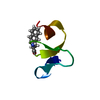
| |||||||||
|---|---|---|---|---|---|---|---|---|---|---|
| 1 |
| |||||||||
| NMR ensembles |
|
- Components
Components
| #1: Protein/peptide | Mass: 3244.841 Da / Num. of mol.: 1 Mutation: Phe 18 has been mutated to the non proteinogenic aminoacid beta-(2-naphthyl)-alanine. Source method: obtained synthetically Details: The residue Phe 18 of the natural AcAMP2 was changed to beta-(2-naphthyl)-alanine. The aminoacid was manually assembled by solid phase synthesis using Fmoc chemistry using standard protocols. References: UniProt: P27275 |
|---|
-Experimental details
-Experiment
| Experiment | Method: SOLUTION NMR | ||||||||||||
|---|---|---|---|---|---|---|---|---|---|---|---|---|---|
| NMR experiment |
|
- Sample preparation
Sample preparation
| Details | Contents: 2.92 mM AcAMP2F18Nal; 20 mM Phosphate buffer; 90% H20, 10% D20 Solvent system: 90% H20, 10% D20 |
|---|---|
| Sample conditions | Ionic strength: 100 mM NaCl / pH: 5.6 / Pressure: ambient / Temperature: 298 K |
-NMR measurement
| Radiation | Protocol: SINGLE WAVELENGTH / Monochromatic (M) / Laue (L): M / Scattering type: x-ray |
|---|---|
| Radiation wavelength | Relative weight: 1 |
| NMR spectrometer | Type: Bruker AMX / Manufacturer: Bruker / Model: AMX / Field strength: 500 MHz |
- Processing
Processing
| NMR software |
| ||||||||||||||||||||
|---|---|---|---|---|---|---|---|---|---|---|---|---|---|---|---|---|---|---|---|---|---|
| Refinement | Method: The structures are based on 348 NOE-derived distance constraints, 18 come from cys-cys disulfide bridges Software ordinal: 1 | ||||||||||||||||||||
| NMR representative | Selection criteria: lowest energy | ||||||||||||||||||||
| NMR ensemble | Conformer selection criteria: structures with the least restraint violations Conformers calculated total number: 50 / Conformers submitted total number: 30 |
 Movie
Movie Controller
Controller


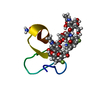
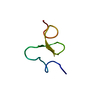


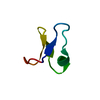
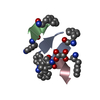
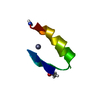

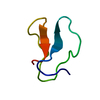

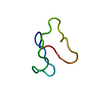
 PDBj
PDBj Amber
Amber